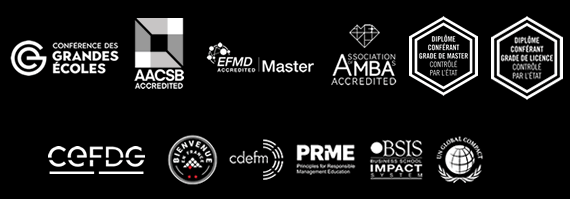Valentine’s Day, the day of love and lovers: what better time to explore the role of Data Analyst at Happn, a leading dating app. Mathieu, from the class of 2021, shares his experience in the Data Analytics Specialisation at the EMLV, his experience as a former Case Growth Analyst, and his vision for the future of online matchmaking.
Originally from Brittany, I went to school in a small town close to Rennes. Once I’d got my baccalaureat, I decided to take a year out to be able to pay for my higher education.
A Master’s in Digital Marketing & Data Analytics with an Apprenticeship to master all things data
This was a very good decision as I was able to discover the world of work at a time when I had few qualifications. I also grew more mature from it (maturity was of course something I lacked at 18 years of age). After I’d established my career objectives and saved up as much money as I could from various unrewarding jobs, I spent three years at Digital Campus Rennes.
It was here that I discovered the dual apprenticeship-study arrangement and the richness of the web.
After discovering the dual education arrangement in my third year, I wanted more. I did all I could to double my advantage and find a Master’s programme that would allow me to continue the dual arrangement.
EMLV’s Digital Marketing and Data Analytics double degree offers students the best of all worlds.
Available in dual education format, it equips students with fundamental web development techniques while also allowing them to develop their strategic and business vision.
When you decide to pursue higher education, it’s also important to choose the right degree for the future career you have in mind. With the Digital Marketing and Data Analytics course, you’ll be getting a double degree as well as a Master’s qualification.
Growth Analyst vs. Data Analyst: two different ways of looking at growth
During the first year of my Master’s at the EMLV, I worked as a Growth Analyst in the Marketing and Data team of Groupe M6 (a French media company). My objective was to develop user engagement and grow the number of active users on the 6play catch-up TV platform using data analytics, product development, AB testing and CRM strategy. In short, we were chasing growth.
However, the reality quickly hit me. 6play had between 3½ and 4 million daily users and a 28 million-strong user base. About 6% of the French population was logging on each day, with about 1 in every two French citizens as a base user (putting aside duplicated accounts).
With these two insights, and having conducted a lot of testing, the team and I understood that growth was not the main challenge we faced.
Having realised this, I shifted to the role of Data Analyst, which was even more central to 6play’s operations. I began working with all the teams, notably the staff of Gulli (a children’s TV channel acquired by M6 in 2019) to integrate all Gulli data into the 6play ecosystem. This involved data extraction, transformation and finally loading, aiming to ultimately automate Gulli’s activity logs.
Above all, the greatest difference between the two roles in my view is the position they occupy within a company. The Growth Analyst targets objectives linked to product or service growth.
He tests new techniques, then shares his results. Then he implements the techniques that work and abandons the ones that don’t. As you can see, the Growth Analyst is very self-sufficient.
The role of Data Analyst is more transversal. It might pursue financial, product or marketing objectives.
It often involves reporting with figures, which are used to make recommendations. The decision making is then left to the stakeholders/interested parties. The two roles, then, are very much close to each other.
Using data to improve user experience on Happn
I joined Happn’s data team about 8 months ago as a Data Analyst in the Product business unit. Officially, my role is to respond to enquiries from the Product and CRM team. I do this by carrying out a wide range of analyses:
- of user behaviour
- of how new features are performing
- predictive analytics using machine learning
- AB tests
I also spend a lot of time presenting the results of analyses and making recommendations which help steer decision making. Making recommendations is the most exciting part for me: there are often nice (or not so nice) surprises!
At Happn, Valentine’s Day is really important for us. We prefer to see it as a celebration of love rather than a day reserved for couples.
We’re there for those going the extra mile to find the perfect Crush (we often experience a spike in activity during this period), as well for those who are aren’t in a rush and prefer to take their time.
It’s worth noting that Valentine’s Day isn’t the only time of year where we see increased activity: such spikes can also occur around the new year period (think new year’s resolutions!) or more recently in summer (which, in the Covid era, has often been accompanied by the lifting of health restrictions).
Video calls, voice notes, digital emotions…the advent of a Happnverse?
It’s interesting to see how things have evolved enormously in the last 2 years alone: during the pandemic, dating apps were a lifeline for single people. They allowed them to maintain social ties and a love life.
At Happn, we responded to these changes in user behaviour by adding, for example, the video call feature, the idea being to go beyond simply exchanging messages, while at the same time making a “Covid-free” first date possible.
The health crisis, then, didn’t stop singles: in 2020, dating apps were downloaded over 560 million times around the world (according to figures from App Annie).
Our objective in the years to come is to continue to narrow the gap between virtual and real-life dates.
The idea is to allow singles to experience the same emotions as they would during love-at-first-sight moments in a bar, in the office, in the street and so on.
For example, we’ve released a set of features dedicated to voice (audio notes attached to profiles, a timeline where you hear the person’s voice before seeing their photo…).
I also keep up to date with all the news regarding the metaverse. It’s surely a bit too soon to imagine how this will influence dating apps, but I’m still intrigued by the technologies emerging there.
Not always, but generally speaking, the Data Analyst’s working environment can appear complex. In reality, it’s easy to get to grips with even with a very limited understanding of data ecosystems.
As far as I can see, the only prerequisite to working as a Data Analyst after you graduate is a basic understanding of SQL, a programming language. It is renowned for its simplicity and allows you to analyse databases /datasets? with just a few lines of code (no need to be afraid of that word).
To summarize, don’t hesitate at the idea of working in a technical ecosystem. Data analysis is less opaque than commonly thought. Be curious and you will find your niche/place there.





















